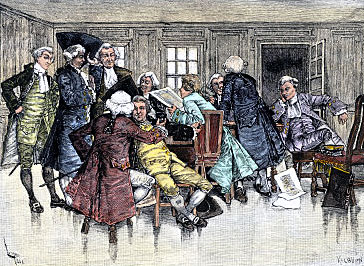By Tara Ross, May 26, 2015
The Constitutional Convention of 1787 met and wrote the language of Article V against this historical backdrop. Any provisions in the document that they wrote should be taken in this context.
The first proposal for a method of constitutional amendments came on May 29, when the so-called Virginia Plan was presented to the Convention. The language in that plan was not specific, but it proposed “that provision ought to be made for the amendment of the Articles of Union whensoever it shall seem necessary, and that the assent of the National Legislature ought not to be required thereto.”[10]
Imagine a world in which Congress was not involved in the amendment process at all! That’s where the Convention delegates began their discussions.
Later, on August 6, the Committee of Detail presented a report in which the language of this section had been revised slightly: “On the application of the Legislatures of two thirds of the States in the Union, for an amendment of this Constitution, the Legislature of the United States shall call a Convention for that purpose.”[11]
Now Congress was involved, but its role was still fairly logistical. It “shall” call a Convention when the states ask for one.
The language changed yet again on September 10, in response to concerns expressed by Elbridge Gerry and Alexander Hamilton. “State Legislatures will not apply for alterations but with a view to increase their own powers,” Hamilton told the Convention.[12] “The National Legislature will be the first to perceive and will be most sensible to the necessity of amendments.”[13] He did not think there was too much danger in giving Congress power to propose amendments, “as the people would finally decide in the case.”[14]
Thus, the language changed again! Now it provided that the “Legislature of the U— S— whenever two thirds of both Houses shall deem necessary, or on the application of two thirds of the Legislatures of the several States, shall propose amendments to this Constitution . . . .”[15]
There was just one small problem. Some delegates thought that the new wording gave Congress too much authority to preempt the states. Matters came to a head on September 15, when George Mason expressed his fear that the “plan of amending the Constitution [is] exceptionable & dangerous.”[16] Both of the modes, as they then existed, depended upon Congress to act. He thought “no amendments of the proper kind would ever be obtained by the people, if the Government should become oppressive, as he verily believed would be the case.”[17]
The language that was finally approved in our Constitution allows Congress to propose amendments on its own, but it also requires Congress to call for a convention if 2/3 of the states make application. Article V reads:
The Congress, whenever two thirds of both Houses shall deem it necessary, shall propose Amendments to this Constitution, or, on the Application of the Legislatures of two thirds of the several States, shall call a Convention for proposing Amendments, which, in either Case, shall be valid to all Intents and Purposes, as Part of this Constitution, when ratified by the Legislatures of three fourths of the several States . . . .[18]
Congress has no power to reject the states’ application. It must call a convention. As Hamilton would later write, “[t]he words of this article are peremptory. The Congress ‘shall call a convention.’ Nothing in this particular is left to the discretion of that body.”[19]
Some opponents of the Article V Convention process have made note of the plural “amendments” in the constitutional text. They argue that states must call for a plenipotentiary convention or none at all. Such an interpretation does not make sense, when the debates in the Constitutional Convention are taken into consideration.
The delegates to the Convention were trying to give the states a way to defend themselves. Why would they then handicap the states by restricting what kinds of conventions they may or may not call?
As one Harvard Journal of Law & Public Policy article concludes:
[T]he purpose of the Convention Clause is to allow the States to circumvent a recalcitrant Congress. . . . The prospect of a [plenipotentiary] convention would raise the specter of drastic change and upheaval in our constitutional system. State legislatures would likely never apply for a convention in the face of such uncertainties about its results, especially in the face of a hostile national legislature. States are far more likely to be motivated to call a convention to address particular issues. If the States were unable to limit the scope of a convention, and therefore never applied for one, the purpose of the Convention Clause would be frustrated.[20]
This is excerpt from TaraRoss.com: Article V: Protecting the “General Liberty or Security of the People”
[10]. 1 The Records of the Federal Convention of 1787, at 37 (Max Farrand ed., 1937) (hereinafter Records of the Federal Convention). Id. at 22.
[11]. 2 id. at 188.
[12]. Id. at 558.
[13]. Id.
[14]. Id.
[15]. Id. at 559.
[16]. Id. at 629.
[17]. Id.
[18]. U.S. Const. art. V.
[19]. The Federalist No. 85, at 525 (Alexander Hamilton) (Clinton Rossiter ed., Signet Classic 2003) (1961).
[20]. Note, The Other Way to Amend the Constitution: The Article V Constitutional Convention Amendment Process, 30 Harv. J.L. & Pub. Pol’y 1005, 1018 (2007).

